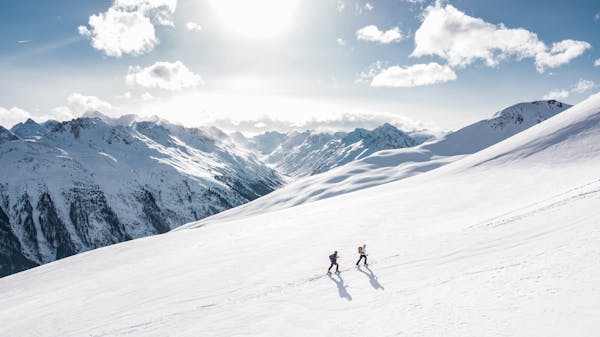
Winter hiking isn’t just about braving the chilly weather; it’s about experiencing nature in a whole new way. Landscapes transform during winter, offering a unique backdrop of snow-covered trails and serene surroundings. This season also means fewer crowds, allowing for a more peaceful and personal connection with the great outdoors. I have wonderful memories of stunning snow hikes I did in Italy.
One might think that summer is the best time to hike, but in Australia like many other parts of the world, the heat can be extreme and even dangerous. Dehydration becomes a real threat. Winter becomes the prime season for hiking enthusiasts. Prepping for cold-weather hiking is crucial for safety and fun. Fluctuating temperatures can catch you off guard, so it’s important to be ready for anything.
The idea of hiking in cold, wet conditions might seem daunting, but the rewards are worth it. Not only do you get to extend your hiking season, but you also have the chance to build new skills. It’s a great opportunity to hone your layering techniques, test your gear, and learn how to stay warm and dry in challenging conditions.
Sydney’s mild winters really allow for enjoyable hiking. We don’t have to contend with snow but cold and sometimes wet conditions.
Winter hiking can also be great for your mental health. Knowing how to hike in winter makes what may seem like a daunting task an enjoyable experience. Embracing the cold and the quiet calm of winter landscapes can offer a break from the hustle and bustle of everyday life. It’s a time to reflect, relax, and enjoy the simple beauty of nature. So, gear up and get ready for an adventure that’s as challenging as it is breathtaking.
Essential Clothing and Gear for Cold-Weather Hiking
Proper clothing is the bedrock of a successful winter hike. Layering is the magic trick.
- Base layer: Start with a moisture-wicking base layer to keep sweat off your skin. This is crucial—nothing feels worse than being damp and cold. Choose materials like synthetic fabrics or merino wool. Skip the cotton; it absorbs moisture and takes forever to dry. This includes thermals to wear under your hiking pants.
- Mid-layer: Next comes the insulating mid-layer. This is your warmth barrier. Think down jackets or fleeces. They trap heat close to your body.
- Outer shell: Finally, top it with a waterproof and windproof shell to shield you from the elements. A good jacket can make or break your hike by keeping wind and rain out while letting moisture escape.
Protecting Your Skin and Extremities
Protecting exposed skin is crucial. Wear waterproof boots and mittens or gloves to keep your extremities warm and dry. Invest in a good hat to keep the heat from escaping your head. Gaiters are essential in keeping snow out of your boots and the bottom of your pants dry. And remember, even in winter, the sun can be harsh due to reflection off the snow, so pack some sunglasses and sunscreen.

Now, let’s talk about some handy extras. Hand warmers can be lifesavers when temperatures plummet. A headlamp is essential for those shorter daylight hours. Also, keep electronics warm to prevent the cold from zapping their battery life. Stash your phone and camera close to your body to keep them functional. A bivvy or heat blanket is essentil as an emergency back-up. Remember, it’s all about being prepared for any situation.
You may want to consider crampons if you are hiking in snow and icy conditions. They provide much-needed traction on slippery or steep terrain. These metal spikes attach to your boots, helping prevent slips and falls while navigating snow-packed trails or frozen surfaces. For winter hiking, especially in mountainous or icy areas, crampons offer safety and stability. I have never really had the need to use them.

By gearing up properly, you set yourself up for a safe and enjoyable winter hiking experience. The right clothes and equipment aren’t just about comfort; they’re about survival. Take the time to prepare, and the winter wilderness will open up to you in ways you never imagined.
Nutrition and Hydration Strategies
Keeping fueled and hydrated is key to staying warm and energized on a winter hike. Your body works overtime in the cold, so it’s important to eat and drink regularly. Simple tip: snack often. Small, frequent bites can keep your energy levels up and prevent that dreaded mid-hike crash.
Dealing with cold and frozen food can be a hassle, so store snacks and meals close to your body—inside a jacket pocket, for instance. This keeps them from turning into ice blocks. Opt for high-energy foods like nuts, dried fruits, and energy bars, which are easy to munch on the move.
Hydration is just as critical. Cold weather can make you feel less thirsty, but your body still needs water. Use insulated bottles or hydration systems to keep your drinks from freezing. Packing warm beverages like tea or hot chocolate can also provide a comforting and warming boost.
Another trick: eat warm meals when you can. A hot lunch isn’t just comforting; it helps maintain your core temperature. You may want to consider a portable stove which can be a bit bulky, but allows you to warm up a meal. Personally, I have never done this.
Remember, your body burns more calories in the cold, so don’t skimp on the snacks and hydration. Consistent fueling and drinking can make all the difference in keeping your energy up and your spirits high.
Understanding and Preventing Cold-Related Injuries
Cold-related injuries are no joke. It’s important to spot the signs early and know what to do if things go south.
Frostbite
- Frostbite happens when your skin and underlying tissues freeze. Keep an eye out for cold, waxy, or numb skin. If symptoms show up, avoid rubbing the area or using hot water. Instead, warm the affected area gently using your body heat or lukewarm water if necessary.
Hypothermia
- Hypothermia is another serious concern. Warning signs include shivering, slurred speech, confusion, and exhaustion. If you or your hiking buddy starts showing these signs, it’s time to act fast. Replace wet clothing with dry layers, wrap them in a blanket, and get them hydrated. If things look severe, seek evacuation immediately.
Managing cold conditions is all about being proactive. If you feel a chill, don’t wait until you’re shivering uncontrollably to add a layer or two. Eating a quick snack can also give you a warmth boost. Remember to set up shelter early if needed, especially when temperatures drop below 50°F or 10°C.
Recognizing early signs of cold exposure can save your hike and maybe your life. It’s about being aware and making quick decisions to stay warm and safe. Keep moving, stay dry, and don’t underestimate the cold. Winter hiking can be fun and safe if you know how to handle these situations.
Planning and Mental Preparation for Winter Hikes
Always check the weather forecast before heading out. Conditions can change rapidly, and being prepared means you won’t get caught off guard. If the forecast looks sketchy, don’t hesitate to postpone your hike. Better safe than sorry.
If you are in high altitudes, the weather can change quickly and unexpectedly. I did a Mont Blanc hike in the summer and experienced hiking in a snow storm as we reached altitude. Being prepared with the right gear is the key.
Knowing your gear inside and out is essential. Practice setting up your shelter and using your navigation tools before you’re out in the wilderness. This not only saves time but also boosts your confidence.
Rain gear should always be easily accessible. Unexpected weather shifts can occur, and staying dry is crucial to maintaining body heat. Pack your gear strategically, with items you might need in a hurry at the top of your bag.
Mental preparation is just as important as physical readiness. Winter hiking comes with its challenges, like getting wet or facing cold winds. Stay positive and remind yourself of the unique and serene beauty you’re out there to experience. Embrace the challenge and celebrate the small victories along the way.
Have a plan for safety and stick to it. Always let someone know your route and expected return time. Carry a map, compass, and possibly a GPS device. Mobile phones can be unreliable in remote areas. Trails become less obvious with a fresh cover of snow, so preparing your route is essential.
Winter hiking is more than a sport; it’s an adventure that builds resilience and brings you closer to nature. With careful planning and a positive mindset, you can fully enjoy the stunning landscapes and the peaceful solitude of the winter trails. Happy Hiking!
If you have any winter hiking experience or any questions, please leave them below.
